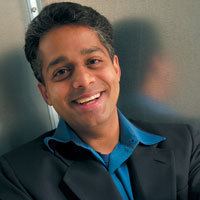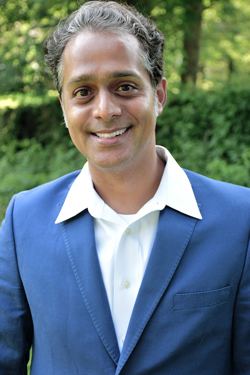Name Rahul Sarpeshkar | Role Engineer | |
 | ||
Books Ultra Low Power Bioelectronics: Fundamentals, Biomedical Applications, and Bio-Inspired Systems | ||
Rahul sarpeshkar synthetic biology approaching biology as an engineering discipline
Rahul Sarpeshkar is the inaugural Thomas E. Kurtz Chair in the William H. Neukom Academic Cluster in Computational Science at Dartmouth College. He holds appointments in four departments as a Professor of Engineering, Professor of Physics, Professor of Microbiology & Immunology, and Professor of Physiology & Neurobiology. Sarpeshkar, whose interdisciplinary work is in bioengineering, electrical engineering, and biophysics, is the first scholar appointed to one of the College’s academic clusters. The clusters, designed by faculty from across the institution to address major global challenges, are part of President Philip Hanlon’s vision for strengthening academic excellence at Dartmouth. Prior to Dartmouth, Sarpeshkar was a tenured professor at the Massachusetts Institute of Technology and lead the Analog Circuits and Biological Systems Group. He is now also a Visiting Scientist at MIT's Research Laboratory of Electronics.
Contents
- Rahul sarpeshkar synthetic biology approaching biology as an engineering discipline
- Rle investigator profile rahul sarpeshkar
- Research Fields
- Research Summary
- Education
- References

On July 7, 2015, Dr. Sarpeshkar was named
Rle investigator profile rahul sarpeshkar
Research Fields
His research has contributed to the fields of:
Research Summary
By mapping log-domain analog electronic circuits to log-domain analog DNA-protein circuits in living cells [1], Professor Sarpeshkar's recent work in the May 2013 edition of NATURE (doi: 10.1038/nature12148) pioneered the field of analog synthetic biology [2]. Professor Sarpeshkar's book [3] introduced a novel form of electronics termed Cytomorphic electronics, i.e., electronics inspired by cell biology [4]. It is based on the astounding similarity between the Boltzmann exponential equations of noisy molecular flux in chemical reactions and the Boltzmann exponential equations of noisy electron flow in transistors. Hence circuits in biology and chemistry can be mapped to circuits in electronics and vice versa. Therefore, this 'cytomorphic mapping' enables one to map analog electronic motifs to analog molecular circuit motifs in living cells as in the work in NATURE and also to simulate large-scale feedback networks in cells with analog electronic supercomputers. Thus, his work has led to a novel and fundamental analog circuits approach to the fields of synthetic biology and systems biology, both of which are highly important in the future of biotechnology and medicine [5]. For example, the synthesis of biofuels, chemicals, energy, molecular and cellular sensors, network drug design, treatments for cancer, diabetes, auto-immune, infectious, and neural diseases can all impacted be impacted by his fundamental work on analog synthetic and systems biology.
Sarpeshkar's work on glucose powered medical implants has been featured in the Economist, WIRED, and Science News and was highlighted by Scientific American among 2012's top scientific breakthroughs [6]. Professor Sarpeshkar's work on a hybrid analog-digital circuit that mimics feedback networks in the brain has appeared on the cover of the journal Nature and has received wide media attention [7]. His work on an ultra-low-power analog cochlear-implant processor for the deaf has had wide impact and been featured in articles in the New York Times [8], Technology Review, and IEEE Spectrum as has work on ultra-low-power brain-machine interfaces for the blind and paralyzed and for cardiac and non-invasive monitoring. His group holds several first and best world records in the fields of medical devices, medical electronics, ultra low power, analog, and bio-inspired design [9].
He has authored more than 125 technical publications and is an inventor on more than thirty five patents. He is the inventor of the RF Cochlea, a rapid radio-frequency spectrum analyzer inspired by the human ear [10]. His book Ultra Low Power Bioelectronics: Fundamentals, Biomedical Applications, and Bio-inspired Systems is published by Cambridge University Press and provides a broad and deep treatment of the fields of analog, ultra low power, biomedical, biological, energy-harvesting and bio-inspired design. It is based on a course that Sarpeshkar has taught at MIT for many years, which emphasizes how the universal language of analog circuits provides a pictorial and intuitive method for analyzing differential equations in physics, chemistry, biology, engineering, and medicine. He has won the Junior Bose award and the Ruth and Joel Spira award for excellence in teaching at MIT.
Professor Sarpeshkar has received several awards including the NSF Career Award, the ONR Young Investigator Award, the Packard Fellows Award and the Indus Technovator Award. He is an Associate Editor of the IEEE Transactions on Biomedical Circuits and Systems and serves on the program committees of several technical conferences. His invited Google Tech talk at the 2011 Frontiers of Engineering Conference, hosted by the National Academy of Engineering (NAE) summarizes some of his unique and interdisciplinary bioengineering research [11].
Education
Sarpeshkar received B.S. degrees in Electrical Engineering and Physics from the Massachusetts Institute of Technology and the Ph.D. degree in Computation and Neural Systems from the California Institute of Technology. His adviser at Caltech was Carver A. Mead. He was a Member of Technical Staff at Bell Labs in its Department of Biological Computation within its Physics Division.
